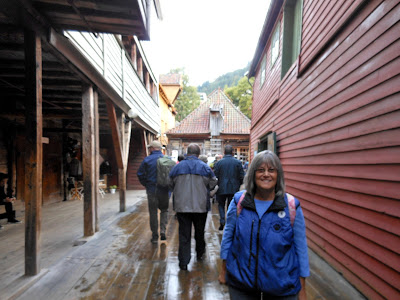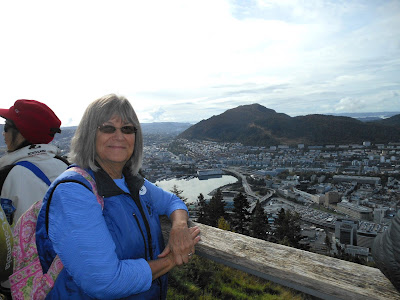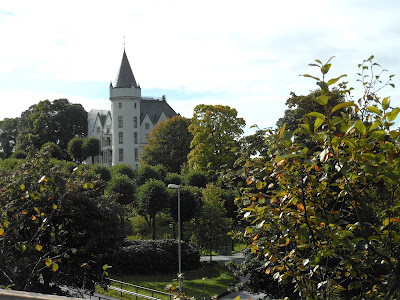Day 3 Bergen Wednesday, Sept 13, 2017
This is from Mt. Fløyen overlooking Bergen's harbor. I'm sure you already noticed that I wore my Norwegian-flag-looking shirt that day! (although no one else seemed have noticed. lol) We awoke as we were still an hour away from the harbor, and we entered from the channel you can see in the upper left side of the picture.
I scooted outside as the ship was approaching Bergen and took my very first photo of the entire trip, just after we passed under this bridge. Our arrival time wasn't until 10 am, so we had time to watch our approach and eat breakfast before our excursion. Bergen is Norway's 2nd-largest city with 260,000 people. It turns out that the temperatures here are mild due to the Gulf Stream (we didn't realize the Gulf Stream's effect extended as far as this). It rarely even snows here!
As we docked, I got this photo out the bow from the 14th deck. I thought it was picturesque with its neat and clean harbor houses. I was actually carrying two coffee cups with me, trying to find Janet. I had gotten our coffees but she had left by the time I returned to the room. Her note said she was at the bow. I didn't find her. Her coffee soon was cold; I drank mine! We wished we had walkie talkies, which the Disney cruise had provided in each cabin.
We soon embarked on our excursion to visit the city highlights. Our first stop was only a half mile from the ship, in the old wharf district called Bryggen. It's now a UNESCO World Heritage site, built in 1350 to house the businesses and dwellings of the Hanseatic League (a German maritime trading network during the 14th to 17th centuries).
This is Bryggen from the harbor side. Each of those buildings, made entirely of wood, housed the codfish trading shops and dwellings for the young German men who had to work there for nine years under extremely strict rules (no girlfriends allowed!). Our tour guide was descriptive as to how difficult a life this was, with the work involved in unloading the codfish from the ships arriving from northern Norwegian seas and hanging them to dry and then loading them up again on the ships headed farther south.
The alleyways between the buildings were narrow and oddly built. There were many fires over the centuries that burned down the wooden structures, but they always rebuilt, and always closer and closer to the harbor water. They dumped their refuse and let their sewage flow toward the water, but then filled it in and built on this unstable ground; over time, Bryggen has slowly sunk a little.
This photo illustrates how the buildings have gradually sunk (although they have recently gone below to stabilize them from further shifting). Notice this slanted stairway we ascended to a shop.
This photo shows the old wood sidings of the Bryggen buildings, and how they were built on top of stones as their foundation. Even the pathways here were made of wood.
Such an attractive fish, the cod! I can see why someone carved this monument, because the cod was king for Bergen for hundreds of years. They were caught in northern Norway and dried, which was sufficient to preserve the fish for years. Its protein was a staple for Europe in those days. Its oil was a primary source of fuel (and a dietary source of vitamins A&D, but of course they didn't know that yet). When we toured a museum later in the day, they had dried cods hanging from the ceiling all over the place. So cute!
Another cool-looking old structure in Bryggen. The Hanseatic businessmen would barter with the buyers as far as selling prices linked to quality (e.g., size) and which goods they would be traded for. Once the ships delivered the fish to Northern Germany (the port of Lübeck, mostly), they would return with things such as hops, grains, textiles, iron, rope, glass, candles, and salt.
This elementary school was next to our line to get on the funicular (notice it is from 1740). We commented on how so many children were outside playing; Scandinavian schools are known to allow significant recess time vs. how our schools here don't even have "recess" any more. Many experts attribute all the outside play time to better learning.
We then took the funicular (originally opened in 1918) to this scenic overlook. Luckily, we had great weather because it was supposed to have been cloudy and rainy. See our ship in the lower right?
Looking inland at where most of the population lives. Our bus tour later drove us into the areas you see in this photo. That body of water looks like a lake, but it's actually connected to the bay.
I learned before we departed on this trip that the World Cycling Championships were going to be held in Bergen just after we'd be there! This was exciting for me (as Janet can attest)! Here was a poster in the funicular station showing how the individual time trial was going to be finishing at the top of Mt. Fløyen, and therefore the funicular would be closed to the public. We saw tons of large temporary tents going up along the harbor area to house the officials, teams, and their corporate sponsors and their many events.
The races would be lasting a full week, starting just four days after we were there. On our ship, I "begged" the customer service desk to show the broadcasts on our room or lounge TVs, but to no avail. I tried to make it sound like everyone on board would want to see the races since we had just toured there. Didn't work. During shore excursions later, following the two elite men's races (time trial and road race), we went into bike shops to learn who had won. (Dutch Tom Doumalin took the TT, and amazing Peter Sagan won his third title in a row, barely edging home-town favorite Alexander Kristoff. Years from now, I may forget these important facts!)
Mt. Fløyen also had this playground with one of the country's ever-present trolls. The nearby gift shop had UCI World Champ water bottles, but I sure don't need any more of those, so no UCI souvenirs. However, check this out:
Our only souvenir from Bergen was this troll racing a bicycle! Janet was determined to buy this. The tourist shops sold dozens of troll toys in every imaginable permutation, but a few of the shops had the foresight to order more of this one, given the World Championships coming to town. They put a line of these in their display windows to catch the eyes of cycling fans, and for us, it worked!
We descended the funicular and our bus tour took us to the other side of the harbor. Mt. Fløyen is that nearby hill on the left, and the Bryggen area is just above and to the left of Janet's head. We drove past their famous fish market, but it had ended for the season. In its place was where many of the UCI tents were going up.
The bus stopped so that we could take this photo of the Norwegian royal family's residence when visiting Bergen. It's called Gamlehaugen, and was built in 1898, with a history dating back to the middle ages.
After the tour and our "free" onboard lunch, Janet and I walked back into town. We first reached this Bergenhus Fortress at the foot of the harbor. Its history dates to the 11th century, but was added to as recently as WW II. It's been a royal residence, a cathedral, housed several churches, the bishop's residence, and a Dominican monastery. It's now used for concerts and "public feasts." We could have toured part of it, but elected not to.
This was the cool entry gate to the fortress, on a cobbled street.
We then re-entered Bryggen and did some shopping, and also toured the Hanseatic Museum, which was housed in one of the old original wooden buildings. We learned in detail about Bryggen's history and got to see how the German boys lived, and where the elders gathered socially.
The ship departed at 8:00. I forget what the theater show was that night, but we liked all the shows.




















No comments:
Post a Comment